Ada Lovelace (1843)
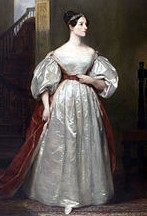 Lovelace's own annotations to a paper by Italian engineer, Federico Menabrea, described for the first time how
a hypothetical 'Analytical Engine' could be programmed before the first computer was even invented.
Lovelace's own annotations to a paper by Italian engineer, Federico Menabrea, described for the first time how
a hypothetical 'Analytical Engine' could be programmed before the first computer was even invented.
ENIAC (1946)

The coders for the pioneering ENIAC project in the USA were an all female team consisting of Kathleen MacNulty,
Jean Jennings, Betty Snyder, Mary Wescoff, Frances Bilas and Ruth Lichterman. They established core software principles
used today, such as using break points (- pausing a program at various points while it's running -) to help debug (or "fix")
faulty computer programming. The modern computer as we know it had not yet been invented, so the ENIAC computer
was an odd looking object. It was as big as a room, with wires and flashing buttons. However, it was able to direct a missile!
Find out more about the ENIAC coders
here.
Ida Rhodes (1949)
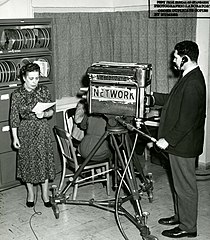
Rhodes developed and programmed some of the earliest computers. She was a Ukrainian Jewish female mathematician at a time when
this was not very common. Rhodes co-designed a computer programming language called C-10. It was for a computer called the UNIVAC I,
which was the first general-purpose electronic digital computer made for businesses in the USA.
Katherine Johnson (1953)
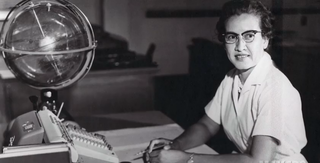 Johnson was an Afro-American maths genius and "human computer" whose calculations put the first ever American astronaut in space.
She worked for NASA and NACA (the organisation that was the predecessor for NASA) for 33 years and helped pioneer the use of
machine computers to perform the task of calculating complex trajectories (flight paths) in space. She worked for NASA's
Project Apollo and Project Mercury. For Project Mercury, she verified the first calculations of an actual electronic computer.
A NASA biography of Katherine Johnson can be found
here.
Johnson was an Afro-American maths genius and "human computer" whose calculations put the first ever American astronaut in space.
She worked for NASA and NACA (the organisation that was the predecessor for NASA) for 33 years and helped pioneer the use of
machine computers to perform the task of calculating complex trajectories (flight paths) in space. She worked for NASA's
Project Apollo and Project Mercury. For Project Mercury, she verified the first calculations of an actual electronic computer.
A NASA biography of Katherine Johnson can be found
here.
Annie Easley (1950s-70s)
 Annie Easley joined NASA in 1955 and worked at the agency for 34 years. In the 1960s, Easley wrote the computer code used for the
Centaur rocket stage (the base from which take-off happened). The Centaur was used in more than 220 launches. Easley’s code was the
basis for future codes that have been used in military, weather, and communications satellites. You can find out 5 facts about Easley
here.
Annie Easley joined NASA in 1955 and worked at the agency for 34 years. In the 1960s, Easley wrote the computer code used for the
Centaur rocket stage (the base from which take-off happened). The Centaur was used in more than 220 launches. Easley’s code was the
basis for future codes that have been used in military, weather, and communications satellites. You can find out 5 facts about Easley
here.
Dorothy Johnson Vaughan (1949)
 Vaughan worked as a mathematician on the SCOUT Launch Vehicle Program that sent America’s first satellites into space.
It wasn’t until racial segregation in the USA ended that she could work with the country’s leading computer operators
and engineers. She became an expert in the FORTRAN programming coding language and became the first black supervisor working
at NASA in 1949. You can listen to a talk about black women in America who worked as human computers during the space race
here.
Vaughan worked as a mathematician on the SCOUT Launch Vehicle Program that sent America’s first satellites into space.
It wasn’t until racial segregation in the USA ended that she could work with the country’s leading computer operators
and engineers. She became an expert in the FORTRAN programming coding language and became the first black supervisor working
at NASA in 1949. You can listen to a talk about black women in America who worked as human computers during the space race
here.
Grace Hopper (1954)
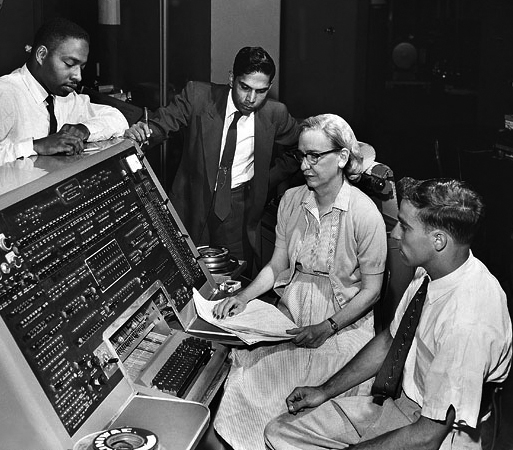 Hopper worked on the world's first programmable computer, the Harvard Mark 1, and was the first to devise machine-independent
programming. Previously, any given coding language only worked on one device... There was no language that could be used
across different computing machines. So, Hopper made the first portable software coding language when she invented FLOWMATIC,
which evolved into COBOL, which is still used today.
Hopper worked on the world's first programmable computer, the Harvard Mark 1, and was the first to devise machine-independent
programming. Previously, any given coding language only worked on one device... There was no language that could be used
across different computing machines. So, Hopper made the first portable software coding language when she invented FLOWMATIC,
which evolved into COBOL, which is still used today.
Hopper also invented the first computer compiler as part of her work, which is a code translater that translates a programming language into machine code. Machine code is something that can be 'read' by a computer, and is always binary, which means it is made-up entirely of zeros and ones. It is necessary to perform this step to make any coding program do-able, because computers only "understand" binary language. Everything we do on a computer is turned into binary for it to be processed, and then turned back into language we understand after the computer has done what we've asked. A short video about Hopper's life can be found here.
Frances E Allen (1957-2002)
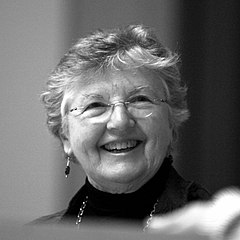 So, now you know what a compiler is! Allen was a pioneer in optimising compilers. She made the long process of
converting software programs into zeroes and ones a lot faster and easier. This work helped established the foundations
of modern computing as we know it. She worked for IBM from 1957 to 2002 and was the first woman to win the Turing Award
in 2006.
So, now you know what a compiler is! Allen was a pioneer in optimising compilers. She made the long process of
converting software programs into zeroes and ones a lot faster and easier. This work helped established the foundations
of modern computing as we know it. She worked for IBM from 1957 to 2002 and was the first woman to win the Turing Award
in 2006.
Margaret Hamilton (1961)

Hamilton was a computer scientist who led the Software Engineering Division of the MIT Instrumentation Laboratory, which in 1961
worked with NASA to develop the Apollo program’s guidance system. Without this, the spacecraft would not have travelled in the correct
direction. The Apollo project took the first astronaut to the moon. Margaret Hamilton was the first person who used the words “software engineering”
to describe her line of work.
Carol Shaw (1978)
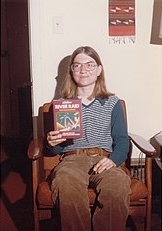
Shaw is one of the first ever female designers and programmers of video games!
She worked for the Atari games company from 1978 to 1980 and created the hugely successful 'River Raid'.
Karen Sparck Jones (1982)

Jones programmed computers to understand human language. She was an English self-taught coder who worked out
how to create a basic search engine… like the ones we use today to look things up on the internet (Google, Yahoo, Duck Duck Go, etc).
Valerie Thomas (1980-current)
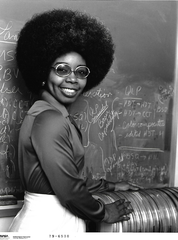 The code of Valerie Thomas allowed NASA to observe the Earth from space for the first time.
Her Illusion Transmitter, patented in 1980, meant that images could be transmitted across long distances
using dome-shaped mirrors. Thomas worked for the Landsat program and wrote the code that took in data from
a Landsat CCT (computer compatible tape) and printed it out in a form that was easy for scientists to read.
She learned and used the coding language FORTRAN for her work. Valerie Thomas is now a mentor for students
through the organisation S.M.A.R.T and she works to encourage the participation of women of colour in science
and tech.
You can hear a talk about her
here.
The code of Valerie Thomas allowed NASA to observe the Earth from space for the first time.
Her Illusion Transmitter, patented in 1980, meant that images could be transmitted across long distances
using dome-shaped mirrors. Thomas worked for the Landsat program and wrote the code that took in data from
a Landsat CCT (computer compatible tape) and printed it out in a form that was easy for scientists to read.
She learned and used the coding language FORTRAN for her work. Valerie Thomas is now a mentor for students
through the organisation S.M.A.R.T and she works to encourage the participation of women of colour in science
and tech.
You can hear a talk about her
here.
Radia Joy Perlman (1984-current)
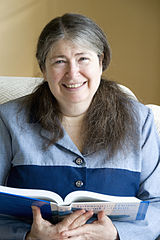
Radia Perlman is most famous for her invention of the spanning-tree protocol (STP). This is not an easy
concept to explain, but her work has had a huge effect on our use of the worldwide web today. Her
many inventions relate to how digital networks, or pathways, work to effectively transmit the information that
we access through the internet.
Elizabeth Feinler (1989-current)
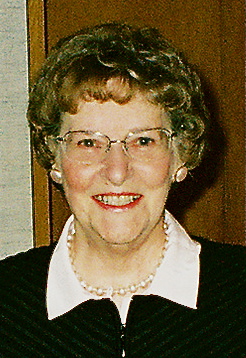
Feinler was an early pioneer in the creation of the internet. She was the director of the Network Information
Systems Center at the Stanford Research Institute and her team operated the Network Information Center (NIC) for the
ARPANET. The ARPANET was an early version of what evolved into the internet. Lots of the domain names that we are
familiar with —.com, .gov, .org, .net, and .edu— come from the work of Feinler and her team.